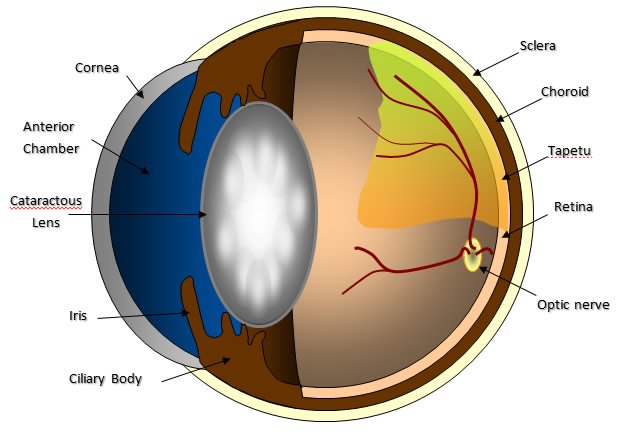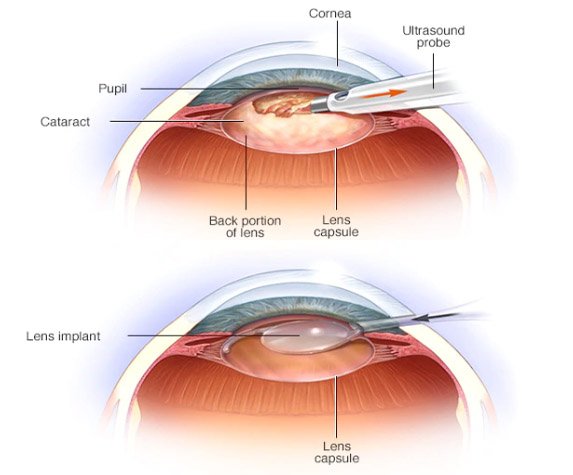How a cataract affects your vision
Cataract surgery is performed to treat cataracts. Cataracts can cause blurry vision and increase the glare from lights. If a cataract makes it difficult for you to carry out your normal activities, your doctor may suggest cataract surgery. When a cataract interferes with the treatment of another eye problem, cataract surgery may be recommended. For example, doctors may recommend cataract surgery if a cataract makes it difficult for your eye doctor to examine the back of your eye to monitor or treat other eye problems, such as age-related macular degeneration or diabetic retinopathy. In most cases, waiting to have cataract surgery won’t harm your eye, so you have time to consider your options. If your vision is still quite good, you may not need cataract surgery for many years, if ever.
Normal vision

Becomes blurred as a cataract forms

Risks
Complications after cataract surgery are uncommon, and most can be treated successfully.
Cataract surgery risks include:
- Inflammation
- Infection
- Bleeding
- Swelling
- Drooping eyelid
- Dislocation of artificial lens
- Retinal detachment
- Glaucoma
- Secondary cataract
- Loss of visione cataract surgery.
Cataract

Before the procedure
A week or so before your surgery, your doctor performs a painless ultrasound test to measure the size and shape of your eye. This helps determine the right type of lens implant (intraocular lens, or IOL).
Nearly everyone who has cataract surgery will be given IOLs. These lenses improve your vision by focusing light on the back of your eye. You won’t be able to see or feel the lens. It requires no care and becomes a permanent part of your eye.
A variety of IOLs with different features are available. Before surgery, you and your eye doctor will discuss which type of IOL might work best for you and your lifestyle. Cost may also be a factor, as insurance companies may not pay for all types of lenses.
IOLs are made of plastic, acrylic or silicone. Some IOLs block ultraviolet light. Some IOLs are rigid plastic and implanted through an incision that requires several stitches (sutures) to close.
However, many IOLs are flexible, allowing a smaller incision that requires few or no stitches. The surgeon folds this type of lens and inserts it into the empty capsule where the natural lens used to be. Once inside the eye, the folded IOL unfolds, filling the empty capsule.
- Fixed-focus monofocal. This type of lens has a single focus strength for distance vision. Reading will generally require the use of reading glasses.
- Accommodating-focus monofocal. Although these lenses only have a single focusing strength, they can respond to eye muscle movements and shift focus to near or distant objects.
- Multifocal. These lenses are similar to glasses with bifocal or progressive lenses. Different areas of the lens have different focusing strengths, allowing for near, medium and far vision.
- Astigmatism correction (toric). If you have a significant astigmatism, a toric lens can help correct your vision.

During the procedure
Cataract surgery, usually an outpatient procedure, takes an hour or less to perform.
First, your doctor will place eyedrops in your eye to dilate your pupil. You’ll receive local anesthetics to numb the area, and you may be given a sedative to help you relax. If you’re given a sedative, you may remain awake, but groggy, during surgery.
During cataract surgery, the clouded lens is removed, and a clear artificial lens is usually implanted. In some cases, however, a cataract may be removed without implanting an artificial lens.
Using an ultrasound probe to break up the lens for removal. During a procedure called phacoemulsification, your surgeon makes a tiny incision in the front of your eye (cornea) and inserts a needle-thin probe into the lens substance where the cataract has formed.
After the procedure
After cataract surgery, expect your vision to begin improving within a few days. Your vision may be blurry at first as your eye heals and adjusts. Colors may seem brighter after your surgery because you are looking through a new, clear lens. A cataract is usually yellow- or brown-tinted before surgery, muting the look of colors. You’ll usually see your eye doctor a day or two after your surgery, the following week, and then again after about a month to monitor healing. It’s normal to feel itching and mild discomfort for a couple of days after surgery. Avoid rubbing or pushing on your eye.




